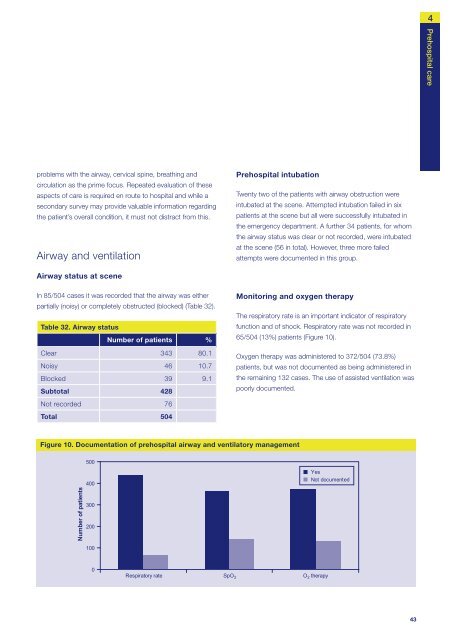NCEPOD: Trauma - Who Cares? - London Health Programmes
NCEPOD: Trauma - Who Cares? - London Health Programmes
NCEPOD: Trauma - Who Cares? - London Health Programmes
Create successful ePaper yourself
Turn your PDF publications into a flip-book with our unique Google optimized e-Paper software.
4Prehospital careproblems with the airway, cervical spine, breathing andcirculation as the prime focus. Repeated evaluation of theseaspects of care is required en route to hospital and while asecondary survey may provide valuable information regardingthe patient’s overall condition, it must not distract from this.Airway and ventilationPrehospital intubationTwenty two of the patients with airway obstruction wereintubated at the scene. Attempted intubation failed in sixpatients at the scene but all were successfully intubated inthe emergency department. A further 34 patients, for whomthe airway status was clear or not recorded, were intubatedat the scene (56 in total). However, three more failedattempts were documented in this group.Airway status at sceneIn 85/504 cases it was recorded that the airway was eitherpartially (noisy) or completely obstructed (blocked) (Table 32).Table 32. Airway statusNumber of patients %Clear 343 80.1Noisy 46 10.7Blocked 39 9.1Subtotal 428Not recorded 76Total 504Monitoring and oxygen therapyThe respiratory rate is an important indicator of respiratoryfunction and of shock. Respiratory rate was not recorded in65/504 (13%) patients (Figure 10).Oxygen therapy was administered to 372/504 (73.8%)patients, but was not documented as being administered inthe remaining 132 cases. The use of assisted ventilation waspoorly documented.Figure 10. Documentation of prehospital airway and ventilatory managementNumber of patients500400300200YesNot documented1000Respiratory rate SpO 2 O 2 therapy43
















